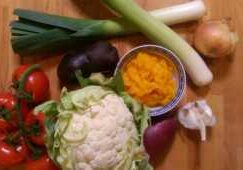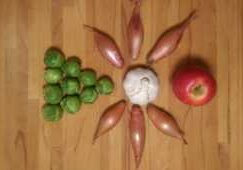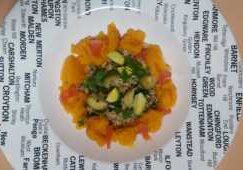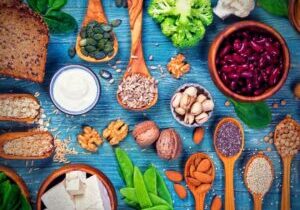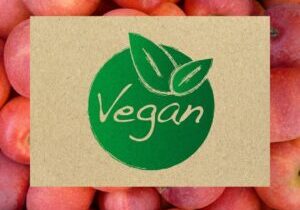Years ago, the only commercial alternative to dairy milk was soya milk. Unfortunately, much of it tasted like wet sawdust. But all of that has changed. Soya milk has grown up! It comes unsweetened or sweetened, in vanilla, chocolate, strawberry or banana flavours, thick or thin and in large or small cartons. Most importantly, it is no longer alone on the shelves.
There are grain milks, made from oats or rice; nut milks made from almond, cashew or coconut; and seed milks such as sunflower or hemp. There are various combinations of these and flavoured versions, too. All of them may be purchased in cartons from most supermarkets.
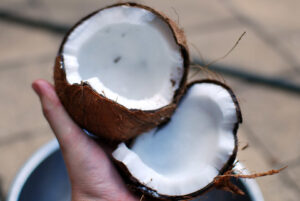 You may wonder why, if the decision is made to eat a vegan diet, one should bother with any form of milk. Well, it’s partly a matter of habit. For instance, generations of people have eaten a breakfast of cereal in milk, even though the same bowl of muesli is delicious when dowsed in fruit juice. Gradually, such patterns and expectations change; plant milks help them to do so!
You may wonder why, if the decision is made to eat a vegan diet, one should bother with any form of milk. Well, it’s partly a matter of habit. For instance, generations of people have eaten a breakfast of cereal in milk, even though the same bowl of muesli is delicious when dowsed in fruit juice. Gradually, such patterns and expectations change; plant milks help them to do so!
However, none of the plant milks replicate dairy milk, nor are they meant to. The only three points of similarity are:
- they are usually white or beige in colour
- they are called milk or milk alternatives
- they are wet and come in a carton or bottle
Plant milks each have their own nutrient profile. They provide various quantities of minerals, protein, vitamins, fat and carbohydrate. Most plant milks are lower in fat than dairy milk and none will add a dairy flavour.
In fact, it gets a bit tiresome to forever compare plant milks with dairy milk. Really, there is no need for comparison. It makes more sense to think of these milks as flavoursome, nutritious drinks made from plant material.
Dairy milk is intended for infant cows or goats or sheep. Its nutritional make-up is specifically matched to growing a creature of that particular species, just as human breast milk is precisely suited to growing humans. While dairy milk and dairy products obviously can provide some nutrients, there is no human nutritional requirement that can be met only by consuming dairy.
Infants and Children
On the subject of growing our young, excellent introductions to plant milk for the very young are oat, rice and almond milks. These are tasty, easy to digest and without the potential for allergic response that soya sometimes can have. Each can be blended with banana, avocado or a little carob molasses to create a delicious and appealing treat with extra nutrient value.
However, plant milks and dairy milks by themselves are never adequate as replacements for breast milk, which is rich in diverse nutrients that are crucial to your baby’s health. Infant formula is available – made with a special range of added nutrients – if you are unable to breastfeed your baby. Currently, infant formula is available based on soya or dairy; there does not yet appear to be an infant formula that is soya-free and also vegan.
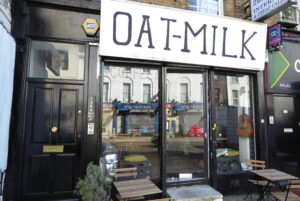 Instead of Dairy
Instead of Dairy
Plant milks are helping people who suffer from milk allergy or lactose intolerance as well as those who find dairy products give them migraine, make their eczema worse or their joints ache. People who have never liked the smell of dairy find plant milks suit them very well because, by and large, they can be used in the same way that dairy milk is used: to make custard, smoothies, white sauce, cream-of-anything soups and hot chocolate.
Each type of plant milk has its own unique flavour, which is generally of a delicate quality. If you buy plant milk in cartons, you may find that some brands fortify the milk with, for instance, vitamin D or calcium or B12. Some add apple juice to create a sweetened form. Take the time to read the labels and find the product that suits you.
Hot Milky Drinks
A favourite warming drink in this household is hot chocolate made with almond, coconut or soya milk. Just heat the milk in a saucepan, then stir in a little syrup or sugar and a scant teaspoon of dark chocolate powder. Serve it into a mug and give it a bubble-making whisk before serving. Perfect!
Most people find that soya milk is excellent in tea, but in coffee is another matter. The problem is that sometimes the milk curdles when added to hot coffee. Not always, just sometimes. Tips and tricks on how to prevent curdling generally are of three types:
- heat the milk a little before you add it slowly to the coffee
- whisk the coffee as you add the milk
- let your coffee cool a little before you add the milk
There seems to be no consensus as to which of the plant milks is best for a latte or cappuccino. A straw poll puts oat milk as the favourite with almond milk a close second. Then come discussions about quality of froth and size of the bubbles. If this is your thing, join in! The easy solution may be to have your coffee black, but the most fun might be to experiment and explore the milky options.
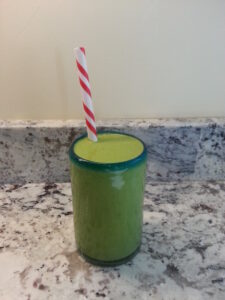 Plant-milk Extras
Plant-milk Extras
In fact, you might extend your search to plant ‘creams,’ currently available in soya or rice form. While you are at it, check out non-dairy yogurts, ice creams, custard-like puddings, hard and soft non-cheeses and butter-like spreads (such as vegan margarines). All of these products are now widely available from health food shops and supermarkets. Many are made from soya but rice, coconut and almond dairy-like products are gaining ground.
It is easy to make your own plant milks and to enhance their nutrient profile by adding other plant ingredients. You can start by using a blender but your job is made much easier if you use an electric plant milk maker. There are a number of these on the market and most of them allow you to make a variety of plant milks, from soya to sesame or even mung bean milks. Using one of these, the process is very quick and the results are excellent: fresh, pure plant milk with no plastics or preservatives and at a very low cost. These machines make an excellent gift, too!
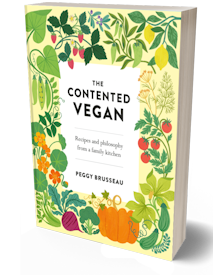
THE CONTENTED VEGAN is a complete guide to the emerging vegan lifestyle. Based on two decades experience of raising a vegan family.
Read Peg's Newsletter...
It's free & fun!
I don’t know if you find it hard to remember web links that are impossibly long and full of gobbledygook?
If you are, then I’ve got some good news…
We’ve made it incredibly easy for you to share a link to my book with your friends – in a way that doesn’t require a degree in programming!
Simply give them this link–
“get.veganbook.today”
No www or anything else – just get dot veganbook dot today. That’ll do the trick – try it!

